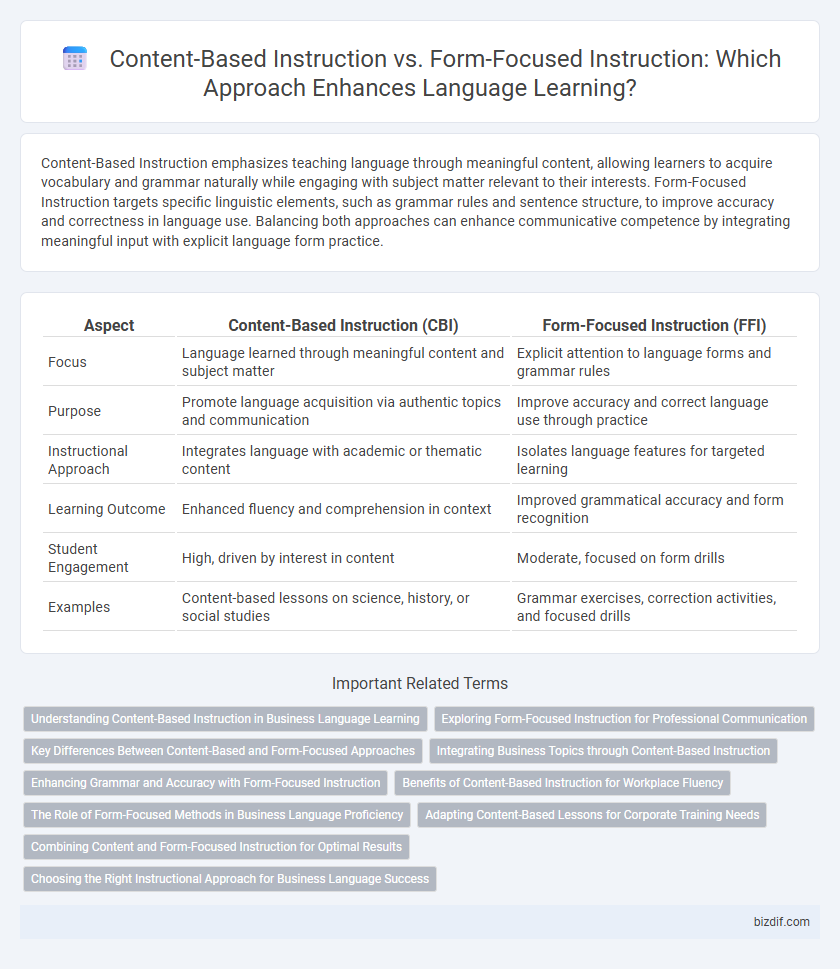Content-Based Instruction emphasizes teaching language through meaningful content, allowing learners to acquire vocabulary and grammar naturally while engaging with subject matter relevant to their interests. Form-Focused Instruction targets specific linguistic elements, such as grammar rules and sentence structure, to improve accuracy and correctness in language use. Balancing both approaches can enhance communicative competence by integrating meaningful input with explicit language form practice.
Table of Comparison
| Aspect | Content-Based Instruction (CBI) | Form-Focused Instruction (FFI) |
|---|---|---|
| Focus | Language learned through meaningful content and subject matter | Explicit attention to language forms and grammar rules |
| Purpose | Promote language acquisition via authentic topics and communication | Improve accuracy and correct language use through practice |
| Instructional Approach | Integrates language with academic or thematic content | Isolates language features for targeted learning |
| Learning Outcome | Enhanced fluency and comprehension in context | Improved grammatical accuracy and form recognition |
| Student Engagement | High, driven by interest in content | Moderate, focused on form drills |
| Examples | Content-based lessons on science, history, or social studies | Grammar exercises, correction activities, and focused drills |
Understanding Content-Based Instruction in Business Language Learning
Content-Based Instruction (CBI) in business language learning integrates language acquisition with subject matter expertise, emphasizing practical communication skills relevant to professional contexts. This approach enhances learners' ability to navigate real-world business scenarios by focusing on meaningful content rather than isolated grammar exercises. CBI fosters deeper engagement and retention by aligning language practice with industry-specific terminology and authentic materials.
Exploring Form-Focused Instruction for Professional Communication
Form-Focused Instruction (FFI) in professional communication emphasizes the explicit teaching of grammatical structures and language forms critical for workplace accuracy and clarity. This approach targets the development of precise language use, improving the ability to construct error-free emails, reports, and presentations essential in professional settings. Research indicates FFI enhances learners' metalinguistic awareness, leading to more effective and confident communication in high-stakes business environments.
Key Differences Between Content-Based and Form-Focused Approaches
Content-Based Instruction (CBI) integrates language learning with subject matter content, promoting fluency and comprehension through meaningful context exposure. Form-Focused Instruction (FFI) prioritizes explicit teaching of grammatical rules, vocabulary, and pronunciation to enhance accuracy and language form recognition. The key difference lies in CBI emphasizing communicative competence via content engagement, whereas FFI targets linguistic accuracy through systematic form practice.
Integrating Business Topics through Content-Based Instruction
Content-Based Instruction (CBI) integrates business topics by using authentic materials and real-world scenarios, enhancing learners' practical language skills within professional contexts. This approach promotes deeper engagement and meaningful communication, aligning language acquisition with specific industry knowledge and vocabulary. In contrast to Form-Focused Instruction, CBI prioritizes content relevance, making language learning more contextualized and applicable for business environments.
Enhancing Grammar and Accuracy with Form-Focused Instruction
Form-Focused Instruction (FFI) targets grammatical accuracy by explicitly highlighting language forms within communicative contexts, facilitating learners' awareness and correct usage of syntax and morphology. Empirical studies demonstrate that FFI improves learners' precise application of verb tenses, subject-verb agreement, and article use more effectively than Content-Based Instruction (CBI), which emphasizes meaning over form. Integrating targeted grammar exercises with meaningful communication ensures enhanced linguistic accuracy and proficiency in second language acquisition.
Benefits of Content-Based Instruction for Workplace Fluency
Content-Based Instruction (CBI) enhances workplace fluency by integrating language learning with meaningful, job-related content, promoting practical communication skills directly applicable to professional tasks. This approach fosters deeper cognitive engagement and contextual understanding, enabling employees to grasp industry-specific terminology and workflows more effectively. CBI supports the development of critical thinking and problem-solving abilities, essential for dynamic workplace interactions and collaborative projects.
The Role of Form-Focused Methods in Business Language Proficiency
Form-focused instruction plays a critical role in developing precise business language proficiency by targeting grammar, vocabulary, and syntactical structures essential for professional communication. This method enhances accuracy and fluency, enabling learners to produce clear, effective reports, presentations, and negotiations in corporate settings. By systematically addressing language forms, form-focused instruction ensures that business professionals can navigate complex linguistic demands with confidence and professionalism.
Adapting Content-Based Lessons for Corporate Training Needs
Content-Based Instruction (CBI) adapts effectively to corporate training by integrating specialized industry knowledge with language learning, enhancing relevance and employee engagement. Tailoring CBI lessons involves aligning authentic business materials such as reports, emails, and case studies with language objectives to boost practical communication skills. Emphasizing meaningful content supports contextual language acquisition, meeting corporate demands for functional fluency and professional competency.
Combining Content and Form-Focused Instruction for Optimal Results
Combining Content-Based Instruction (CBI) and Form-Focused Instruction (FFI) enhances language acquisition by integrating meaningful context with explicit grammar teaching. Research indicates that students achieve higher retention and communicative competence when both content and linguistic forms are targeted simultaneously. Effective language programs leverage authentic materials while incorporating focused instruction on syntax, morphology, and phonology to optimize learning outcomes.
Choosing the Right Instructional Approach for Business Language Success
Content-Based Instruction (CBI) emphasizes learning language through meaningful subject matter, fostering practical language application in authentic business contexts. Form-Focused Instruction (FFI) targets specific grammar and language accuracy, ensuring precision crucial for professional communication and documentation. Selecting the appropriate approach depends on learners' objectives, with CBI enhancing contextual fluency and FFI refining technical correctness for business language success.
Content-Based Instruction vs Form-Focused Instruction Infographic

 bizdif.com
bizdif.com